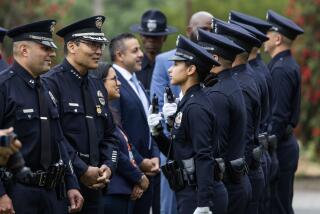Bicycle Police Ride High in the Saddle, Build Support in Neighborhoods : Law enforcement: Small towns like State College, Pa., and big cities like San Francisco put officers on bikes with three missions--community relations, crime deterrence and law enforcement.
- Share via
STATE COLLEGE, Pa. — It’s a little bit “Adam-12,” a little bit Tour de France.
More and more cities and towns are putting police officers on bicycles, letting them feel neighborhoods as though they’re walking a beat, but giving them transportation in case they’re needed to fight crime.
“Flatfoots on bikes,” said Carol Juth, a criminologist at Hope College in Holland, Mich. “They get to know a small area. Trust starts to build up. It has a very good psychological advantage for the neighborhoods.
“It also gives police a better sense of who belongs in the neighborhood and who doesn’t,” she said.
Small towns like State College and big cities like San Francisco have put officers on bicycles with three missions--community relations, crime deterrence and law enforcement.
Officers buckled into a cruiser are handcuffed in their attempts to accomplish the first two.
“One of the things that people see with cruisers are anonymous cops driving from Point A to Point B,” said Capt. Tim Hettrich of the Potrero Station on San Francisco’s south side. “When they see the bike officer, they all recognize, ‘That’s our officer.’ ”
“A foot patrol officer would go by a place one or two times a day. These officers are there 20 times a day,” said Hettrich, who replaced all of his foot patrol officers after the community donated money to buy six bicycles.
San Francisco started its bike patrols in 1991; State College began its version last summer.
Before them, Ft. Worth, Tex.; Seattle, and Tulsa, Okla., already had self-powered police vehicles. Las Vegas, Newark, N.J., and several cities in Pennsylvania already have them. Hilly Pittsburgh is considering the idea.
The custom-fitted mountain bikes with police gear bolted to the frames are automatic conversation pieces--and the summertime shorts help break down barriers too.
“Children come up to them,” Hettrich said of the pedaling officers. “There’s none of this, ‘You’re the pig. You’re the foe.’ It’s all, ‘What kind of bike are you riding, officer?’ ”
Among the dozen cyclists pulled over for not having headlights in a recent State College patrol--a $74 offense--more than half had questions about the officers’ 21-speed bikes.
Hettrich has a small percentage of his officers assigned to bicycles--six of 118--and uses them only until 9 p.m. Busy streets and rough city neighborhoods make it unsafe for 24-hour bicycle patrols.
But in small towns, particularly college communities, it’s natural for anyone to be on a bicycle anytime, since there are no major highways or high-crime areas.
“We can have them out all hours of the night,” said Tom King, State College’s police chief. “We want the officers to get out into a particular neighborhood--particularly downtown and where the residential areas merge into downtown--and do a good job interacting with the citizens and the public.
“I think it’s better than foot patrol,” he said. “They’re still accessible to the public, but they can cover more territory quicker.”
And the mountain bikes cost less than $1,000. A fully equipped cruiser costs near $20,000.
Juth believes the burgeoning trend of police officers on bikes gives residents a sense that police are a part of the community and not just bystanders until something happens.
“If he’s there, he can talk to them and let them know what to watch for,” she said. “If he’s not, no one gets involved.”
The bicycle officers haven’t been relegated to chasing down wandering drunks or writing scores of traffic citations--although that’s what they often do.
San Francisco bike officers fight a crack cocaine problem some days and, on others, look for ticket scalpers at Candlestick Park. And State College bike officer Rob Keen on an overnight shift nabbed a drunk driver.
“He saw a car go through a red light, caught him at the next red light and stopped him,” King said. “He handled it like a regular violation.”
Well, all except for the fact that no bicycle built for two is assigned to the department, Keen noted. Since no officer was free to bring a cruiser to take the 20-year-old driver to the hospital for a blood alcohol test, Keen left his bicycle with the suspect, walked to headquarters, picked up a car and finished the arrest himself.
The bikes’ mobility provides some advantages, too, that you just can’t get with a cruiser. A San Francisco officer nabbed three purse snatchers by relentlessly pursuing them on city streets, through an alley and around a fence until the youths tired.
“They finally said, ‘We give up. We can’t outrun you,’ ” Hettrich said.
Some officers find their quarry a little embarrassed, no matter the charge, since many of those stopped aren’t used to seeing a self-powered police vehicle.
“It’s bad to get pulled over anytime,” State College officer Brian Hosterman said, “but it’s worse when it’s by a cop on the bike.”
More to Read
Sign up for Essential California
The most important California stories and recommendations in your inbox every morning.
You may occasionally receive promotional content from the Los Angeles Times.










